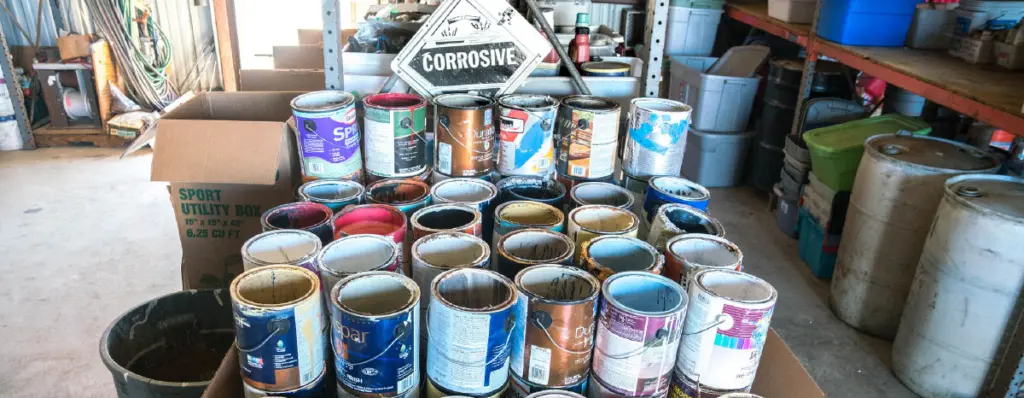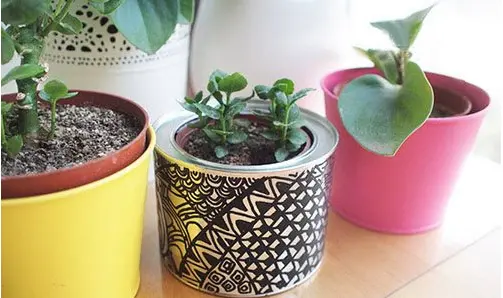Have you ever wondered what to do with those old paint cans in your garage? Helping you reduce waste, reuse materials and recycle responsibly. Paint cans are not your typical trash as they contain harmful substances that can cause harm to the environment if not disposed of properly. Incorporate the 3Rs (reduce, reuse and recycle) into your paint can disposal routine. Discover innovative ways to repurpose old paint cans for storage, craft projects, or even as planters for your garden. We’ll also guide you through proper paint can cleaning techniques and the best ways to dispose of empty cans.

Why it’s important to dispose of paint cans correctly
Proper disposal of paint cans is critical because of the many important factors involved such as safety, environmental protection and regulatory compliance. First, harmful substances such as volatile organic compounds (VOCs) may remain in paint cans, and improper handling may lead to air pollution and health hazards. These harmful substances may evaporate in the environment, causing pollution to the atmosphere and water sources, and posing potential threats to the ecosystem. Secondly, residues in paint cans can have long-term effects on the environment and even affect groundwater quality. Therefore, proper disposal of paint cans can minimize the negative impact on the environment and ensure that our ecological environment is protected.
Safety And Regulations
Additionally, proper disposal of paint cans is a matter of safety and regulatory compliance. There may be flammable substances accumulated in paint cans, which may cause serious accidents such as fire or explosion if not handled correctly. Additionally, localities often have regulations regarding hazardous waste disposal, and noncompliance with paint cans can result in legal liability and fines. Therefore, proper disposal of paint cans is not only environmentally responsible, but also a necessity for public safety and regulatory compliance.
The importance and methods of reducing paint tin waste
Paint tin is one of the common wastes in paint construction and use, and reducing this tin waste is of great environmental, resource and economic significance. By taking a series of effective measures, we can minimize the waste of paint tin and contribute to sustainable development.
Choose the right amount of paint
Before your painting project begins, carefully calculate the amount of paint you will need. Excess paint not only increases costs, but also results in more waste. Accurately estimating the amount of paint needed and choosing the right amount of paint is the first step to reducing waste.
Precisely mix paint
For colors or formulas that need to be mixed, make sure you mix them in exact proportions. Inaccurate mixing will not only result in suboptimal application results, but may also render some paint unusable and become waste. By mixing paint accurately, we maximize every drop of paint and reduce waste.
Store and protect paint properly
Proper paint storage and protection practices can extend the life of paint and reduce waste caused by expired paint. Making sure the paint cans are well sealed and stored out of direct sunlight and large temperature changes will help maintain the quality of the paint and reduce unnecessary wear and tear.
Use environmentally friendly paint
Choosing to use environmentally friendly paint is an important way to reduce waste. These paints typically contain fewer harmful substances and have a smaller impact on the environment. By choosing environmentally friendly paint, we can not only reduce the generation of hazardous waste, but also contribute to the development of the green and environmentally friendly industry.
Proper cleaning and recycling of paint cans
After using a paint can, make sure the paint inside the can is as clean as possible. Cleaned cans can then enter appropriate recycling processes, reducing negative impact on the environment. Recycling paint cans helps turn waste into reusable resources and promotes the development of a circular economy.
Paint Tin Disposal Creative method: reuse paint cans, environmentally friendly and beautiful
Paint cans often become waste during decoration and maintenance. Međutim, through creative thinking, we can reuse these cans, which is not only environmentally friendly, but also adds a unique beauty to life.


Garden art
Spray-paint discarded paint cans in a variety of bright colors and place them in your garden to create unique flower pots or works of art. You can choose to paint a variety of patterns on the jars to create personalized garden decorations and give discarded jars a second life.
Paint can disposal creative storage containers
By adding some creative touches to a paint can, you can transform it into a stylish storage container. You can add colorful fabrics, decorative stickers to the jars, or even wrap them with string, ribbon, and other materials. Not only is this treatment beautiful, it also makes the paint can a functional decorative addition to your living space.
Lighting design
Transforming discarded paint cans into unique lamps can bring unique light and shadow effects to your home. By drilling holes, spraying or inlaying transparent materials on the cans, you can design a variety of unique lighting effects to create a warm and personalized atmosphere in the room.
Tool organization
Take advantage of the sturdy nature of a paint can and transform it into a practical tool organizer. Adding dividers or hooks to jars makes it easy to store various gadgets and make the workplace cleaner and more organized.
Kids toys
Paint cans transform into fun children’s toys. By adding some brightly colored decorations, or making shapes like animals, cars, itd. on the jars, you can stimulate children’s creativity and imagination while also reducing waste generation.
Paint can disposal DIY decorations
Cut paint cans into various shapes to make DIY decorations, such as vases, handicrafts, itd. Through spraying, stickers, cutting and other treatments, you can create unique home decorations to show your personality and creativity.
Paint can disposal: part of environmental action
As a widely used material in construction, maintenance and decoration, the correct recycling of paint cans is an important measure to protect the environment and resources. Here are some ways to properly recycle paint cans to ensure that discarded cans are properly disposed of and reduce negative impact on the environment.
Paint can cleaning
Before recycling paint cans, be sure to clean them. Clean the remaining paint in the can with the corresponding solvent to ensure that there is no paint residue on the surface of the can. This helps improve recycling efficiency and avoid mixing in toxic waste.
Differentiate waste categories
Sort recycled paint cans into different types of waste. Some paint cans may be classified as hazardous waste and require special handling in accordance with local regulations. There are opportunities to separate and recycle metals, plastics and other materials to improve the efficiency of resource reuse.
Recycling site selection
Choose a legal recycling site to recycle paint cans. Some communities or cities have specialized waste recycling centers, which can usually provide professional waste sorting and treatment services. Make sure you choose a reliable recycling site to ensure your paint cans are properly disposed of.
Participate in the manufacturer program
Some paint manufacturers offer recycling programs that accept discarded products from their production. Understanding the manufacturer’s recycling policies and actively participating in these programs can help ensure that discarded paint cans are efficiently reused or disposed of.
Door-to-door recycling service
Some areas offer door-to-door recycling services for waste, including paint cans. Knowing about the services provided by local government or private organizations can make it easier for residents to hand over their discarded paint cans to professional organizations for recycling.
Paint Can Disposal Regulations and Guidelines: Ensuring Environmentally Compliant Handling
Proper disposal of paint cans is a critical step in ensuring environmental and public safety when using paint. Countries and regions have regulations and guidelines in place to regulate the disposal of paint cans. Here are some general regulations and guidelines to ensure paint cans are handled in an environmentally compliant manner.
waste regulations
Most countries and regions have relevant waste regulations that include disposal requirements for paint cans. These regulations typically specify requirements for waste classification, packaging, labeling and transportation. Businesses and individuals should follow local waste regulations when disposing of paint cans to ensure the waste is properly disposed of.
Hazardous waste regulations
Paint cans may contain harmful substances such as volatile organic compounds (VOCs). Regulations regarding the disposal of hazardous waste are often more stringent, requiring specialized handling and proper disposal. When handling paint cans, you need to pay special attention to the harmful ingredients in them and dispose of them correctly in accordance with relevant regulations.
Environmental label
Paint cans should usually be marked with environmental protection labels and corresponding waste classification marks. This helps identify the contents of the can and ensures appropriate measures are taken during waste disposal. When handling paint cans, it is very important to read and follow the markings on the can.
Paint Can Cleaning Guide
Proper cleaning is necessary before discarding paint cans. A suitable solvent needs to be used during the cleaning process to ensure that the paint residue in the can is completely removed. Cleaned paint cans are easier to sort and dispose of correctly.
Professional recycling services
Some areas offer specialist waste recycling services, including the recycling of paint cans. These services usually comply with relevant regulations to ensure that waste is properly disposed of. Individuals and businesses can contact these services to have their discarded paint cans professionally disposed of.
By understanding and following these regulations and guidelines, we can ensure that paint cans are disposed of in an environmentally friendly and compliant manner, reducing potential risks to the environment and human health. When disposing of paint cans, companies and individuals should actively fulfill their social responsibilities, follow relevant regulations and guidelines, and contribute to sustainable development.
The importance of choosing environmentally friendly paint
As environmental awareness increases and the importance of sustainable development gradually emerges, people are paying more and more attention to environmental factors when choosing construction and decoration materials. In this context, choosing environmentally friendly coatings becomes crucial. Here’s a look at the importance of choosing environmentally friendly coatings and the positive impact it can have on the environment, health and sustainability.
Reduce emissions of volatile organic compounds (VOCs)
Traditional paints contain a large amount of volatile organic compounds. These substances will evaporate into the air after the paint is applied and have a negative impact on indoor air quality. Choosing environmentally friendly paints usually means they contain lower levels of VOCs, which can help reduce indoor air pollution and create a healthier indoor environment.
Reduce the impact on human health
Volatile organic compounds are a class of substances considered harmful to human health. They may cause headaches, eye irritation, respiratory discomfort, and other symptoms. By choosing environmentally friendly coatings, we can reduce the risk of exposure to these harmful substances and protect the health of ourselves and our families.
Support sustainable development
Many environmentally friendly coatings use renewable, degradable or recycled raw materials, helping to reduce the consumption of natural resources. This choice helps support sustainable development, reduces the burden on the planet and drives the construction industry in a more environmentally friendly direction.
Ecosystem protection
Some ingredients in traditional paints may have adverse effects on the environment, such as heavy metals, toxic solvents, itd. Environmentally friendly coatings usually use more environmentally friendly raw materials, reducing the burden on the ecosystem, helping to maintain ecological balance and protect the natural environment.
Comply with regulations and standards
More and more countries and regions have introduced environmental regulations and standards for coatings and coating products. Choosing environmentally friendly coatings that comply with these regulations and standards is the social responsibility of enterprises and individuals. This not only helps ensure product quality, but also drives the entire industry to develop in a more sustainable direction.
Improve quality and durability
Many environmentally friendly coatings focus on R&D and innovation to improve product quality and durability. Environmentally friendly paints are generally more durable and offer a longer service life, reducing the need for frequent paint replacements and thus less waste.
To sum up, choosing environmentally friendly coatings is not only responsible for individual and family health, but also an active participation in the sustainable development of the earth. During the coating selection process, we should pay attention to the product’s environmental label, ingredient list and corresponding certification to ensure that the selected coating truly meets environmental standards and contributes to a greener future.
Taking responsibility for paint can disposal: contributing to environmental protection
In our daily life and work, we often use paint for construction, decoration and maintenance work. Međutim, paint cans often become waste during use, and proper disposal of these cans is everyone’s responsibility and a way to contribute to the environment. Here’s a look at the importance of taking responsibility for paint can disposal and what you can do in practice.
Environmental responsibility
Proper disposal of paint cans is a concrete manifestation of environmental responsibility. Everyone who uses paint should be aware of the impact that discarding the cans will have on the environment. Taking responsibility for the disposal of paint cans is to protect the environment in which we live, maintain ecological balance, and actively respond to the call for environmental protection.
Prevent environmental pollution
Improper disposal of discarded paint cans can lead to the release of harmful substances, causing contamination of air, water and soil. By properly disposing of paint cans, we can prevent these harmful substances from entering the environment and protect the health of natural ecosystems.
Maintain public safety
There may be flammable substances left in the paint cans, which may cause fire or explosion hazards if not handled properly. Taking responsibility for the disposal of paint cans is to maintain public safety, reduce the occurrence of waste-related accidents, and ensure social stability and tranquility.
Compliance with laws and regulations
There are often regulations around the disposal of waste, including paint cans. Taking responsibility for paint can disposal means adhering to relevant regulatory compliance requirements and avoiding legal liability and fines due to improper handling. This is the obligation and responsibility of every member of society.
Promote circular economy
Proper disposal of paint cans can help drive a circular economy. By recycling and reusing discarded cans, the demand for raw materials can be reduced, the service life of resources can be extended, waste recycling can be achieved, and society can be promoted towards the goal of sustainable development.
Promote community involvement
By promoting community participation, we can develop the correct concept of waste disposal at a social level. Organize or participate in waste cleanup activities, encourage neighbors to participate, cultivate more people’s environmental awareness, and create a good atmosphere for the community to work together for environmental protection.
Practical methods
There are practical ways we can take responsibility for paint can disposal. This includes cleaning up your discarded cans, choosing a legal recycling site for delivery, participating in the manufacturer’s recycling program, or repurposing the cans in creative ways such as garden art, storage containers, itd.
Paint can disposal in conclusion:
In daily life, the correct disposal of paint cans is an environmental responsibility that everyone should bear. Through efforts to prevent environmental pollution, maintain public safety, comply with regulations and promote circular economy, we can contribute to creating a cleaner, safer and more sustainable social environment. By assuming the responsibility for the disposal of paint cans, we are not only a practitioner of environmental protection, but also a performer of social responsibility, making a positive contribution to future sustainable development.
